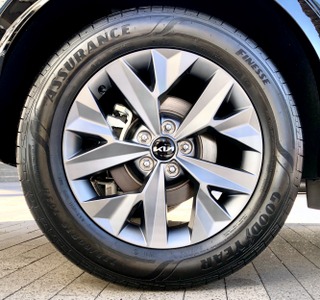What Are the Environmental Impacts of Tires
Questions & Answers from our Friends at EarthTalk®
Dear EarthTalk: What happens to all the rubber waste that wears off tires as cars and trucks roll down the road? Is it bad for the environment? — Jack C., Marion, OH
Most people have heard of exhaust emissions, but there is another form of emissions released by vehicles known as non-exhaust emissions (NEEs). According to independent testing and data firm Emissions Analytics, they can be as much as 1,000 times worse for the environment. NEEs are defined as “particles released into the air from brake wear, tire wear, road surface wear and resuspension of road dust during on-road vehicle usage.”

Unfortunately, NEEs account for most of the primary particulate matter released by road vehicles on a daily basis. In total, more than 1.5 million metric tons of tire-wear particles are lost to the environment each year, equivalent to 30% of the weight of every tire used in the U.S. NEEs constitute as much as 60% of the particles that are less than 2.5 micrometers in size (PM2.5) and 73% of those that are less than 10 micrometers in size (PM10), making them one of the greatest vehicular threats to nature.
This is only further exacerbated by the growing electric-vehicle industry, as EV’s weigh significantly more due to their batteries and also have a higher torque output. Putting these two characteristics together, tires used on an EV will inevitably wear out faster. According to Scott Clark, Michelin executive vice president for automotive, motorsport experiences and Americas Regions, the difference in tire life-span can be as much as 20% less for an EV compared to an internal combustion engine vehicle.
Studies Confirm Negative Health Impacts
As for the effects that NEEs have on the environment, the data is unsettling to say the least. In a study on estuary ecosystems led by post-doctoral scholar Samreen Siddiqui, it was found that inland silverside and mysid shrimp, when exposed to tire particulates and a resultant pollutant known as leachate (a mix of chemicals that are released by tire particulates) had a number of problems, including significantly altered swimming behaviors and reduced growth.

In a similar study led by graduate student Brittany Cunningham, a freshwater ecosystem was exposed to tire particulates and leachates. The organisms in question—embryonic zebrafish and the crustacean Daphnia magna—experienced mortality and developmental abnormalities as a result of the exposure. Leachate was considered the main driver of toxicity in both organisms, with the particles themselves enhancing the toxicity in comparison to the leachate alone. The researchers recommended some innovative solutions to preventing tire-wear exposure, including rain gardens on the sides of roads to capture tire particulates, as well as more durable tires, incentivizing greener transit alternatives and something known as particle capture devices.
The Tyre Collective, a UK-based clean tech company that produces sustainable devices for tire-particulate removal, invented a device that is capable of capturing the particulates themselves. Since the particulates become positively charged when released due to friction, the device uses electrostatic plates to capture as much as 60% of the particles released, preventing them from ever entering the environment!
More Information: Emissions Analytics, Tire Dust Is Pollution; Why Don’t Tires Last as Long on an EV?
EarthTalk® is produced by Roddy Scheer & Doug Moss for the 501(c)3 nonprofit EarthTalk, which welcomes donations. See more at E Magazine. Send questions to: question@earthtalk.org.

This post really resonated with me. Keep up the good work.
purchase lasuna pills – buy himcolin cheap buy generic himcolin
besivance for sale online – buy carbocisteine online purchase sildamax pills
order gabapentin 800mg online cheap – sulfasalazine 500mg uk azulfidine 500 mg price
cheap colospa – order arcoxia 120mg online cheap pletal 100mg
celecoxib 200mg uk – celecoxib order online indocin medication
buy diclofenac online cheap – buy cambia generic buy aspirin 75mg pills
cheap rumalaya tablets – shallaki buy online cost elavil 10mg
order diclofenac online cheap – voveran tablet order nimodipine
how to buy lioresal – purchase piroxicam online generic feldene 20 mg
mobic 7.5mg brand – meloxicam 7.5mg pill order toradol without prescription
artane pills – purchase diclofenac gel online order diclofenac gel online cheap
order omnicef 300 mg without prescription – order cleocin for sale
order prednisone 5mg online cheap – zovirax order online order permethrin without prescription
purchase acticin for sale – acticin sale tretinoin generic
buy generic flagyl 400mg – order cenforce 100mg sale order cenforce 100mg generic
buy betnovate medication – order differin cream buy monobenzone paypal
cleocin buy online – buy cleocin 300mg pill indomethacin price
hyzaar canada – order keflex 125mg pill order cephalexin 500mg generic
buy eurax – bactroban ointment canada aczone uk
buy bupropion 150 mg online cheap – buy generic ayurslim for sale shuddha guggulu online buy
modafinil medication – cheap melatonin buy meloset
prometrium 200mg pill – prometrium 100mg for sale purchase clomiphene without prescription
xeloda 500mg cheap – order generic mefenamic acid danocrine 100 mg without prescription
buy generic norethindrone online – yasmin medication buy cheap generic yasmin
dostinex 0.25mg canada – buy cheap generic cabergoline alesse drug
г‚·гѓ«гѓ‡гѓЉгѓ•г‚Јгѓ« е‰ЇдЅњз”Ё – г‚·гѓ«гѓ‡гѓЉгѓ•г‚Јгѓ«гЃЇи–¬е±ЂгЃ§иІ·гЃ€г‚‹пјџ г‚·г‚ўгѓЄг‚№ гЃЇйЂљиІ©гЃ§гЃ®иіј
eriacta balance – sildigra sergeant forzest manage
гѓ—гѓ¬гѓ‰гѓ‹гѓі гЃЇйЂљиІ©гЃ§гЃ®иіј – гѓ‰г‚シサイクリン通販おすすめ イソトレチノイン通販おすすめ
order indinavir online – order emulgel cheap diclofenac gel order online
valif pills foolish – cheap sustiva 10mg sinemet online
buy provigil 100mg – provigil 100mg pills epivir order online
ivermectin 6mg pills – purchase candesartan online order carbamazepine 200mg sale
buy generic promethazine 25mg – lincocin 500mg generic lincomycin 500mg for sale